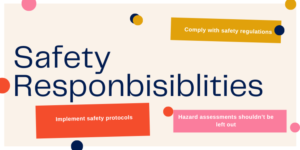Safety shares (which can go by many other names including Toolbox Talk, Tailgate Safety Meeting, and Safety Moments) are informal discussions or presentations that focus on various safety issues.
Workplace Safety Topics for Meetings to Bookmark
- General Safety Mistakes
- Ergonomic and Workplace Stress
- Drugs on The Job
- Violence at The Workplace
- Fire and Electrical Safety
- Workplace Accidents: Reporting, Prevention, And Costs
- Heat Exhaustion and Safety
- Workplace Injuries
- Silica Dust and Protection
- Communication Issues and Safety
- Working At Altitudes
- Lightning Safety
- Allergies
- Seasonal Changes
- When To Have A Safety Share
- Stroke Awareness
- Prescription Drug
- Drill Safety
- Fatal Risk Management In Mining – Critical Control Field Verifications
- Terrorist Incident Response Training
- Fatal Risk Management In Mining
- Be Aware Of The Little Decisions
- Home Chore Safety
- Summer Bike Safety
- Hazard Identification
- Checking Your Surroundings Before You Drive
- Check Your Surroundings Outdoors, Be Aware And Anticipate Hazards
- Ladder Safety
- Tick Bites/Outdoor Hazards
- Look Up And Live
- Safe At Work/Safe At Home
- Adjusting To A New Schedule
- Holiday Lighting/Ladder Safety
- Icy Roads And Turkey Fryers
- Lightning
- Tire Replacement
- 5 Fundamentals Of Safety
- Alcohol And Cold Weather
- Earthquake Awareness
- Safety Gates In The Home
- Wildfires
- Gasoline Generators/Carbon Monoxide
- Winter Driving
- Vehicle Maintenance.
1. General Safety Mistakes
Proper use of personal protective equipment (PPE) is one of the simplest ways to ensure the safety of your employees. It’s crucial to advise and train employees in using protective equipment, such as prescription lenses, protective hearing devices, foot and arm protection, and other protective equipment.
For example, it’s wise to ask employees to wear hard hats if there’s a danger of falling objects in the workplace. Inform them about using face shields and gloves to prevent scratches, cuts, or possible infections
2. Violence in The Workplace
Workplace or occupational violence can result from employees, customers, visitors, or clients engaging in any kind of disruptive behavior.
This violence could include an act or threat of physical violence, harassment, intimidation, or even homicide. Safety meetings should address the policies and procedures organizations have in place to deal with violent acts on the job.
3. Fire and Electrical Safety
t’s good for employees to know what to do in the event of a fire accident at the workplace. Safety meetings present a chance to cover topics such as how to minimize the effects of fire, prevent the fire from spreading, and save lives. It’s also good for the workers to know:
- The whereabouts of fire extinguishers
- How to use fire extinguishers
- Quick evacuation routes if/when necessary
Accidents caused by electricity can often be fatal. Knowing how to be careful with electrical equipment and devices at work is of the utmost importance. It’s vital for any safety meeting to discuss the consequences of not wearing proper protective gear while working with electrical wires or being careless around them.
4. Workplace Injuries
Accidents or injuries in the workplace can occur due to many reasons. Some of the most common causes are:
- Trips and falls
- Lifting
- Being hit by unguarded machinery or falling objects
- Violent acts in the workplace
- Stress, fatigue, and overexertion
- Vehicle-related mishaps
- Repetitive motion injuries
- Exposure to hazardous materials
Talking about how such injuries happen and what workers can do to avoid them should be a key element of a safety meeting. Organizations should inform workers on procedures and training that help protect them from accidents in the workplace.
5. Ergonomic and Workplace Stress
Ergonomic stress can cause long-lasting and acute injuries. Employees should be aware of ergonomics risk factors in the workplace in order to avoid them. Repetitive tasks, overexertion, and sustained awkward postures can lead to lifetime injury or pain. Workers should regularly stretch, exercise, and do strength training to avoid ergonomically induced injuries.
Work-related stress, fatigue, depression, and anxiety also account for a large percentage of workplace health issues. Uneven workload patterns, toxic cultures, infrequent breaks, and many other factors can contribute to stress and discomfort. To reduce work-related stress, try to:
- Ask for help
- Communicate problems clearly
- Meditate and try other relaxation techniques
Creating a work culture that encourages conversations about stress and work-life balance promotes a www.qodargroup.com/safety-atricles/




